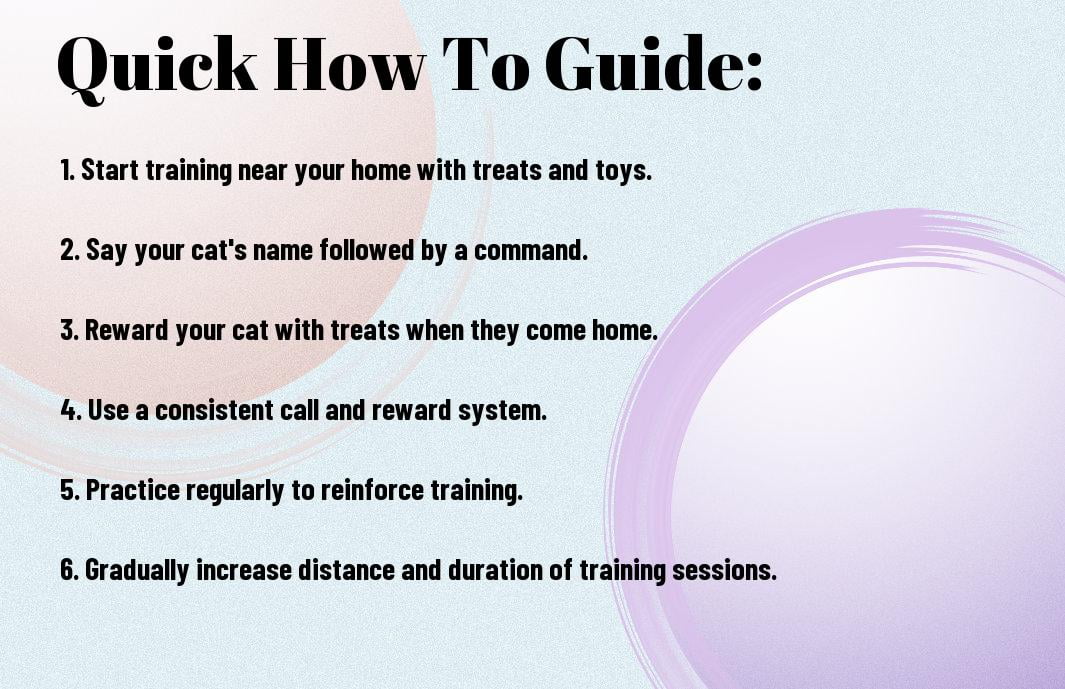Training your outdoor cat to come home is an vital skill that can provide peace of mind for cat owners. By implementing a few simple strategies, you can help ensure your furry friend returns home safely each day. Whether you have a curious explorer or a wandering kitty, these training techniques can help strengthen the bond between you and your outdoor cat while keeping them safe and close to home.

Preparing for Training
If you have an outdoor cat that you’d like to train to come home, it’s vital to prepare yourself and your cat for the training process. By taking some time to think about safety considerations and gather vital supplies, you’ll set yourself up for success in training your outdoor cat to come home reliably.
Safety Considerations
An important aspect to consider when training your outdoor cat is their safety. Before you start any training, ensure that your cat is up to date on vaccinations and has proper identification, such as a collar with ID tags or a microchip. It’s also crucial to provide your cat with a safe outdoor environment, free from potential dangers like traffic, other animals, or toxic plants. Remember to supervise your cat during training sessions to prevent any accidents or mishaps.
Essential Supplies for Training an Outdoor Cat
An vital part of training your outdoor cat is having the right supplies on hand. Some key items to have include a sturdy leash and harness for taking your cat outside safely, tasty treats to reward good behavior, and a comfortable resting area for your cat to relax after training sessions. Additionally, consider using a clicker to mark desired behaviors and a training mat to create a designated space for training activities.
Training your outdoor cat requires patience, consistency, and the right tools to help them learn effectively. By having the necessary supplies ready, you can create a positive and engaging training environment for your cat to thrive in.
This chapter focuses on preparing for training your outdoor cat to come home. By considering safety precautions and gathering vital supplies, you can set yourself and your cat up for a successful training experience.

Training Basics
Some outdoor cats tend to roam far and wide, but training them to come home on command is possible with patience and consistency. It is imperative to establish a routine and create positive associations with coming home to ensure your feline friend’s safety and well-being.
Establishing a Routine
An imperative first step in training your outdoor cat to come home is establishing a consistent routine. Cats are creatures of habit, so setting regular feeding times and keeping a consistent schedule for outdoor exploration can help your cat develop a sense of predictability and security. Create a designated spot in your home where your cat knows they will always find food, water, and comfort.
First Steps: Associating Home with Positives
Basics such as food, treats, and affection can help create a positive association with coming home for your outdoor cat. Start by offering treats or a favorite meal when your cat returns home on its own. This positive reinforcement will help your cat understand that returning home results in rewards and affection, making them more likely to repeat the behavior in the future.
With consistency and patience, your outdoor cat can learn to associate coming home with positive experiences, ultimately strengthening the bond between you and your furry companion.
Training Techniques
The Call-Back Method
All outdoor cats can benefit from knowing how to respond to a call-back technique. This involves consistently using a specific sound or phrase when calling your cat back home. By using this method every time you call your cat, they will begin to associate the sound with coming back home. It is imperative to be patient and consistent when implementing this technique, as it may take some time for your cat to understand and respond to the call-back signal.
Using Visual and Audio Cues
Techniques using visual and audio cues can be effective in training your outdoor cat to come home. Visual cues could include using a flashlight or waving a brightly colored item to catch your cat’s attention. Audio cues, such as a whistle or a specific noise, can also be used to signal your cat to return. These cues can help strengthen the connection between the signal and the desired behavior of coming home.
With positive reinforcement practices, you can encourage your cat to respond to the visual and audio cues consistently. When your cat comes home in response to the signals, reward them with treats, pets, or praise to reinforce the behavior. Consistency is key in training your cat, so be sure to always reward them when they come back home after hearing or seeing the cues.
Positive Reinforcement Practices
Cues that elicit positive reinforcement are imperative in training your outdoor cat to come home. By using treats, praise, or playtime as rewards when your cat comes back home, you are reinforcing the desired behavior. Positive reinforcement creates a strong association between the action of returning home and the positive outcome, making your cat more likely to repeat the behavior in the future.
Factors Influencing Training Success
To successfully train your outdoor cat to come home, there are several factors that can influence the success of your training efforts. These factors include the age and adaptability of your cat, as well as their personality and behavior patterns. Understanding these factors can help you tailor your training approach to best suit your cat’s needs.
Age and Adaptability of Your Cat
Clearly, the age and adaptability of your cat play a significant role in how easily they can be trained to come home. Younger cats are generally more adaptable and open to learning new behaviors, making them easier to train. Older cats, on the other hand, may be more set in their ways and resistant to change. However, with patience and consistent training, cats of any age can learn to come home when called.
Perceiving your cat’s level of adaptability and adjusting your training techniques accordingly can make a big difference in the success of your training efforts. Remember to be patient and consistent, as it may take some time for your cat to learn to come home reliably.
Personality and Behavior Patterns
With each cat having its own unique personality and behavior patterns, it’s important to consider these factors when training your outdoor cat to come home. Some cats may be more independent and less motivated by food rewards, while others may be more social and eager to please. Understanding your cat’s individual traits can help you tailor your training approach to best suit their needs.
To effectively train your cat, it’s important to establish a strong bond built on trust and positive reinforcement. By creating a positive association with coming home, you can encourage your cat to respond consistently to your calls. Remember to be patient and consistent in your training efforts, as each cat will progress at their own pace.
Tips for Maintaining Training Progress
Keep the following tips in mind to ensure your outdoor cat continues to come home reliably:
Creating a Cat-Friendly Outdoor Environment
- Make sure your outdoor space provides shelter, food, water, and a comfortable resting area for your cat.
- Include scratching posts, toys, and climbing structures to keep your cat mentally stimulated and physically active.
Assume that a happy and content cat in the outdoor environment is more likely to respond positively to training.
Consistency in Training Sessions
One crucial aspect of maintaining your cat’s training progress is to be consistent with your training sessions. Set a routine schedule and stick to it. Cats thrive on consistency and predictability, so ensuring regular and structured training sessions will help reinforce the desired behavior. Remember to use the same cues and rewards consistently to avoid confusing your cat.
Maintaining a consistent training schedule will help your outdoor cat remember and respond to the training commands more effectively over time. Practice makes perfect, and the more consistent you are with your training, the more likely your cat is to come home when called.
Troubleshooting Common Issues
Issues like distractions, fear, or changes in the outdoor environment can affect your cat’s training progress. If your cat starts exhibiting avoidance behavior or reluctance to return home, reassess the training approach and environment. Consider using higher-value treats, decreasing distractions, or providing more incentives for your cat to come home.
Progress in training your outdoor cat to come home may face setbacks due to various factors. By identifying and addressing common issues promptly, you can maintain the training progress and continue strengthening the bond with your feline friend.

Advanced Training Concepts
Unlike indoor cats, training your outdoor cat to come home requires advanced techniques and patience. Here are some concepts to take your training to the next level:
- Expanding the Training Beyond Your Home:
| Location: | Even though your cat is used to coming home, it’s crucial to practice in different locations to ensure they will return no matter where they are. |
| Distractions: | Introduce distractions gradually during training sessions, such as noises or moving objects, to prepare your cat for unexpected situations. |
Preparing for Unexpected Situations
Even with the best training, unexpected situations can still occur. Prepare your outdoor cat for various scenarios by introducing them to different environments and distractions. Now, your cat will be more likely to return home safely, even in unfamiliar settings.
Plus, consider using a GPS tracker or a collar with your contact information in case your cat wanders off too far. This extra precaution can give you peace of mind knowing you can locate your cat quickly in case of an emergency.
To wrap up
Drawing together all the tips and techniques discussed, training your outdoor cat to come home can be a manageable task with patience and consistency. By establishing a routine feeding schedule, using positive reinforcement techniques, and creating a safe outdoor environment, you can help your cat associate coming home with rewards and security.
Remember to be patient with your cat as they learn this new behavior, and always provide a safe and comfortable space for them to return to. By using these methods and staying dedicated to the training process, you can help ensure that your outdoor cat comes home safely and reliably.
FAQ
Q: Why is it important to train my outdoor cat to come home?
A: Training your outdoor cat to come home is crucial for their safety and well-being. It allows you to have control over their whereabouts and helps prevent them from getting lost or injured while exploring outside.
Q: Can all outdoor cats be trained to come home?
A: Yes, with patience and consistency, most outdoor cats can be trained to come home. It may take time, especially for older cats, but with positive reinforcement and rewards, they can learn to respond to your call.
Q: How can I train my outdoor cat to come home?
A: Start by establishing a routine feeding schedule and calling your cat at the same time every day. Use a distinct whistle or call their name loudly to get their attention. Reward them with treats or praise when they come to you.
Q: What should I do if my outdoor cat doesn’t come home when called?
A: If your cat doesn’t respond to your call, remain calm and try again later. Avoid chasing or yelling at them, as this may scare them further away. Consider using a toy or food to lure them back home.
Q: Are there any tools or devices that can help train my outdoor cat to come home?
A: Yes, there are modern solutions like GPS trackers or electronic collars that can aid in training your outdoor cat to come home. These devices can provide you with peace of mind and help locate your cat if they stray too far.
















